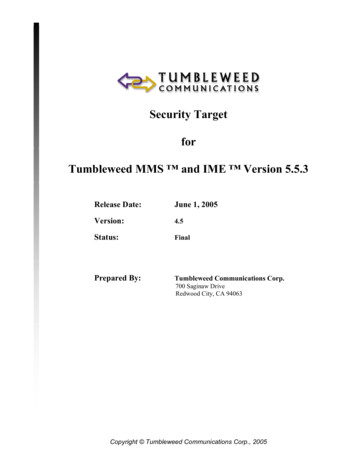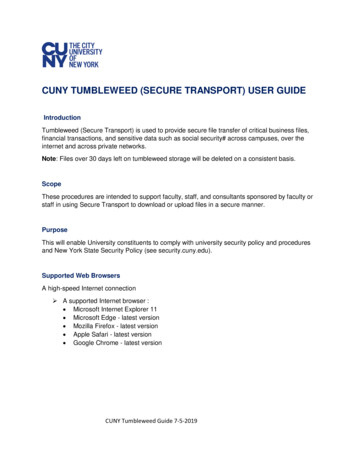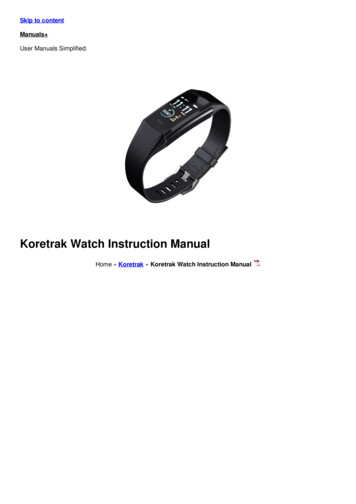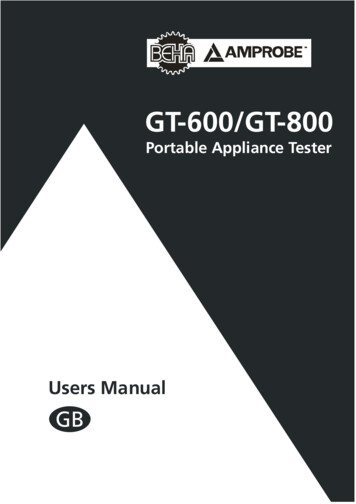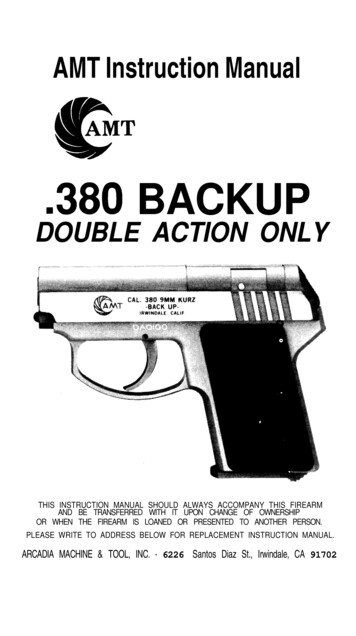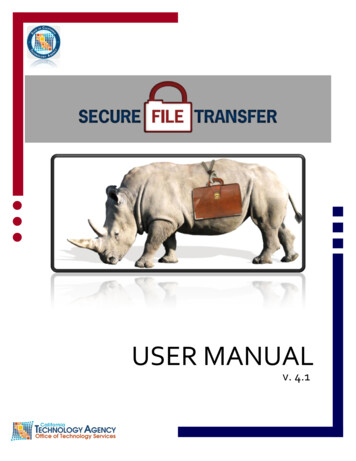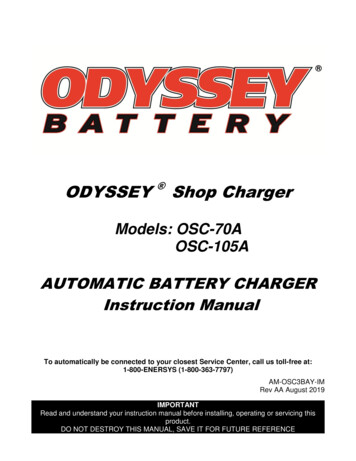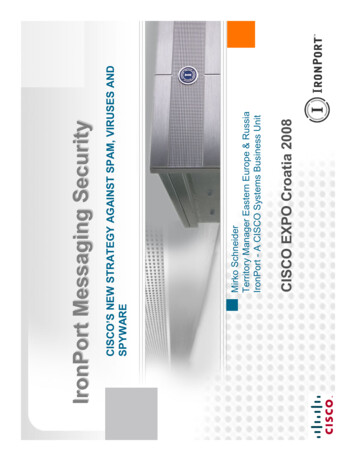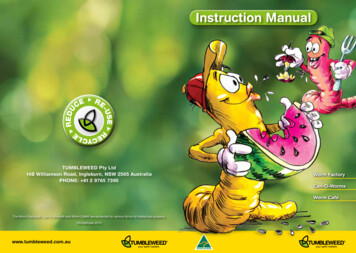
Transcription
Instruction ManualTUMBLEWEED Pty Ltd14B Williamson Road, Ingleburn, NSW 2565 AustraliaPHONE: 61 2 9765 7395Worm FactoryCan-O-WormsWorm CaféThe Worm Factory , Can-O-Worms and Worm Cafe are protected by various forms of intellectual property. N.Nattrass 2010www.tumbleweed.com.au
12IntroductionWhich Worms Are For You?Congratulations on the purchase of your new TUMBLEWEED Worm Farm.There are thousands of species of earthworms worldwide, all of which feed on someThis exciting and revolutionary composting system is the result of years of research andform of organic matter but their preferences and habitats differ. Worms can be dividedongoing development. The first domestic worm farms were introduced to the Australianinto two broad categories depending on those preferences:market in 1993 as The Worm Factory and Can-O-Worms . We have continued thiscommitment by introducing the Worm Café and worm farm accessories which willensure you find the right worm farm and accessories for you.Composters: There are less species of these, mainly ‘Tigers’,‘Reds’ and ‘Dendras’. These earthworms live and breed happilyin an organic rich environment like a TUMBLEWEED WormWorms are Mother Nature’s unique natural recyclers. By putting wormsFarm or in a heavily mulched garden where moisture and foodto work in your very own, easy-care farm, you will be converting your foodis maintained. Use these in your TUMBLEWEED Worm Farm towaste into nutrient rich, 100% organic fertiliser that your potted plants, gardenensure successful composting.and vegetables will love. Whether you have purchased the Worm Factory (single working tray), the Can-O-Worms (two working trays), or the WormCafé (three working trays). These generic instructions will allow you to harvest thepower of composting worms. You can personally become a part of the revolution toreduce landfill and Greenhouse Gases by recycling your food scraps.TUMBLEWEED Worm Farms are user-friendly and can be left on a balcony or in alaundry for apartment dwellers, in a shed or in a shaded location for those with a yard.It is important that you place them somewhere that avoids afternoon sun. Put yourssomewhere convenient so that it makes it easy for you to use.What Happens To Food & Garden Scraps In Landfill?Earthworkers: These are the many other earthworms which prefer to livein a less controlled environment. They will not thrive on food scraps but prefer soil andhumus as their basic diet. They are usually much larger than composters.Setting Up Your Worm Farm1. Assemble your worm farm as per your unit’s instructions found on the reverse ofyour packaging. You only need 1 Working Tray to start with, keep any others asidefor later use.2. Locate in a cool position in afternoon shade. Morning sun is OK.3. S etting up Working Tray 1. Fill a bucket with about 7 litres of water and place yourTUMBLEWEED Worm Farm Bedding Block in it. As the bedding block expands,begin to break it up into an even mix. It should take about 15 minutes. Use thepaper wrapper too. All the paper and cardboard packaging has beendesigned to be worm friendly.4. F old and place your cardboard packaging into the base ofWorking Tray 1. Then spread the expanded worm beddingblock on top of this. The worms will eventually eat all thebedding and cardboard.www.tumbleweed.com.au
345. S pread your worms (minimum of 1000 composting worms) on top of the bedding,and cover with a TUMBLEWEED Worm Blanket. Now fit the lid and let the wormssettle in for one or two days. This is the worms ‘home’ tray. Feed your worms in thistray first (refer to “Feeding Your Worm Farm” below).6. It will take 3 - 6 months for this 1st working tray to become full. When the compostlevel in the ‘home’ tray is high enough to touch the base of the tray added above it,you may add Working Tray 2. Once again when Working Tray 2 is full you can addWorking Tray 3. If ever a gap appears between the trays you must top up the lowerWorking Tray with some extra organic compost, bedding or coir. This allows theworms access to move up into the tray above.Note: If you have a worm farm with only one working tray,when it is full, you will need to move the top 50-60mm of thesurface material from one side, across to the other side, and thenremove some of the rich black worm castings from lower down inthe tray. Then level out the materials still left in the working tray,(should be only about half full now as you have removed some ofthe bottom worm castings). Now continue feeding the top of the tray.Alternatively, you may just feed one side of the Working Tray. This will allow youto harvest the worm castings from the side you are not feeding at any given time.Or: You could purchase extra working trays to stack on top to make it a bit easierto manage.3. Place food under the TUMBLEWEED Worm Blanket. Never cover theentire feeding surface of your worm farm at one time.4. Feed your worms with your normal kitchen vegetable scraps.Avoid large quantities of meat, citrus, onion, and dairy foods.5. Sprinkle a handful of garden soil (or organic potting mix) on top of thefood scraps every time you feed your worms.6. Once a weak sprinkle a teaspoon of TUMBLEWEED Worm Farm and CompostConditioner when feeding your worms.7. Each week flush your worm farm with water – worms like a very moist environment.Flush your worm farm by tipping a ½ - ¾ filled bucket of water (5 litres or more)under your TUMBLEWEED Worm Blanket in your top Working Tray. Ensure your tapis fully opened with a bucket underneath. Keep your tap turned on until the waterstops dripping. Some people prefer to keep their tap open all the time, make sureyou keep a bucket underneath to collect the worm tea. It is best to regularly drainwater out of the worm farm, because water stored in the bottom tray will becomestale and could begin to smell.8. Drain your Collector Tray at least weekly. The worm tea can be further watereddown (10:1) so that it looks like weak tea and used as a fertiliser on your pot plantsand garden.Feeding Your Worm FarmMy Worm Farm Is Full1. Feed your worms only as much as they can eat. Maintain no more than 2cm of1. Lift off the top Working Trays.food over half the surface of the Working Tray. If your worm farm goes smelly youare most likely overfeeding your worms. If smelly, stop feeding for a few days,and scratch and gently aerate the top 50 - 60 mm of materials with a small pointedtool or piece of wood.2. Chop up food scraps as small as possible before feeding to worms.www.tumbleweed.com.auNote: If you have a worm farm with only one working tray, when it is full, you willneed to move the top 50-60mm of the surface material from one side, across to theother side, and then remove some of the rich black worm castings from lower downin the tray.
56Then level out the materials still left in the working tray, (should be only about half fullof worm retailers or have a look through ads in magazines or the Yellow Pages.now as you have removed some of the bottom worm castings). Now continue feedingAlso your local council may promote worm composting and be able to direct you to athe top of the tray. Alternatively, you may just feed one side of the Working Tray.local supplier. We recommend that you purchase a minimum of 1000 compost worms.This will allow you to harvest the worm castings from the side you are not feeding atany given time.Or: You could purchase extra working trays to stack on top to make it a bit easierto manage.2. I f your system has two or more working trays, lift the lowest Working Tray off theCollector Tray. Empty worm castings out of the lowest Working Tray, and use onyour potted plants or in your herb and veggie garden. Now clean the emptyWorking Tray.3. P ut the now emptied Working Tray on top of the other Working Trays.This commences the cycle of rotating the trays. Make sure there are no gapsbetween the trays. The lowest Working Tray just emptied, becomes the new topWorking Tray where you feed your worms.Note: It is also a good idea to clean out the Collector Tray at this time. There can be aconsiderable amount of worm castings deposited down here over time, by the worms.4. W orm castings are one of natures best fertilisers. Used on your garden or pottedplants, you will see exceptional results.Worm Farming Questions & AnswersFollowing are some of the most commonly asked questions we get asked from peopleusing a TUMBLEWEED Worm Farm. Peter Rutherford, renowned Ecologist and WormFarm Expert has provided the answers below:Q.1 Where can I obtain compost worms?A. Composting worms are now available from most hardware and garden outlets.You may also find suppliers via the internet, visit www.tumbleweed.com.au for a listwww.tumbleweed.com.auQ.2 How much will my worms eat?A. This depends on how many worms you have. Worms can eat up to half their ownbody weight every day and can double their population every few months.If you start your TUMBLEWEED Worm Farm with 1 pound/450 gramsof mature worms (identify mature worms by a distinct ring shapedswelling around their body) they will consume up to half a pound/225 grams of food waste per day. After a few months you shouldhave doubled your worm population and you can feed them more.The baby worms, however, won’t eat much and will take about 3months to mature. As you become familiar with them you will learn theirrate of food consumption. If you are feeding too much, the excess food will go anaerobic and begin to smell.If the top working tray becomes smelly, stop feeding for a few days or even a week,sprinkle with a teaspoon full of TUMBLEWEED Worm Farm & Compost Conditioner,and mix it in with a small fork or spike.Q.3 How can I help the worms to eat more?A. Worms will feed at a faster rate once they have adapted to any new food source.Worms will also eat more if food scraps are mashed, blended or cut up more.Controlling temperature to around 24C (70F ) will improve the overall performanceof your TUMBLEWEED Worm Farm. Worms will leave very acidic food such asonions and orange peels until after they have eaten their preferred foods. A handfulof crushed oyster shells or ashes from a fire will help to balance the effect ofacidic foods or sprinkle with a teaspoon of TUMBLEWEED Worm Farm & CompostConditioner once a week. The regular addition of Worm Fattener (recipe page 12)will encourage stronger, fatter worms. Since they consume up to half their own bodyweight each day, the fatter the worms the more food scraps they will eat.
78Q.4 What shouldn’t I feed my worms?A. Be careful what you feed your worms particularly if you are unaware of its source.Manure from horses, cattle or dogs often carry vermicides intended to kill parasiticworms in the animal. These vermicides can kill all your worms in one day.Q.5 Can I feed my worms garden refuse?A. Not usually. TUMBLEWEED Worm Farms are designed to break down soft organicfood scraps. Slow composting organic wastes such as garden refuse are best dealtwith by conventional aerobic composting methods. Use a TUMBLEWEED 220L or400L Compost Bin or Compost Tumbler designed to compost garden waste.Q. 6 I’ve had my TUMBLEWEED Worm Farm for a month now, but theworms don’t seem to be eating any of my food scraps?A. The worms may be still be eating your Worm Farm Bedding material. If you haveused kitchen scraps in addition to your Worm Farm Bedding Block the worms willeat through this before eating any introduced food.Q.7 Should I add water to the TUMBLEWEED Worm Farm?A. Watering of your TUMBLEWEED Worm Farm will enhance the production of liquidfertiliser. Food wastes usually contain about 80% water. This is released as theworms break the food down. This will tend to stay in the bedding for a long timebefore eventually draining out. Any dry material such as newspaper or cardboardshould be presoaked before being added. It is important to keep a TUMBLEWEEDWorm Blanket over the freshly added food to encourage the worms to move up tothe surface to feed. This will provide a dark damp shelter for them. Once every week, pour about 5 litres of fresh water into the TopWorking Tray, which will flood down through the lower trays andensure that the entire worm farm is very moist. Worms love anenvironment with a moisture content of 70% or more, as longas the excess water can drain off and does not become ‘stale’(ie anaerobic). This practice is especially important in the hotter months of the year. Place anempty bucket under the open tap, you will have a constant supply of liquid fertiliser.The sudden ‘flood’ will not harm the worms.Q.8 Will I get too many worms?A. No, you will never have too many worms. They will regulatetheir population to the confines of available space andthe amount of food you give them. Your worm populationshould reach about 5,000 to 10,000 worms after about oneyear. Some TUMBLEWEED Worm Farms have been knownto house up to 20,000 worms under ideal conditions anddiligent management.Q.9 Can I put compost worms in the garden?A. Yes as long as you have a thick surface layer of mulch on your garden.Compost worms require moist conditions all year round because they don’t tend totunnel deep like Earthworker worms to find moisture.Q. 10 Why aren’t the worms moving up from the lower levels into thetop working tray?A. This situation can arise for two reasons. First, you may be adding new food toosoon before the worms can eat the previous food. This will result in a lot of uneatenfood scraps being distributed throughout the system and a general reluctance by theworms to migrate upwards while they can still access material lower in the system. Before adding new trays, stop feeding the worms for at least a week to ensure thatall existing food in the lower tray has been eaten. Worms will then move up to eat from the surface as this is their naturalbehaviour pattern. Secondly, you may not have waited for the level of worm castings in your TopWorking Tray to get full enough in the tray before adding the next tray. This willcreate a gap between the trays preventing the worms from reaching the top tray.www.tumbleweed.com.au
910If there is a gap between any two working trays, simply lift off the top tray and addQ.14 How do I keep ants out of my TUMBLEWEED Worm Farm?some organic soil or organic potting mix to the tray beneath, put the top tray back onA. Ants will enter your TUMBLEWEED Worm Farm if you have a lot of them in yourand continue operation.Q.11 What about severe temperatures?A. Worms will tolerate a wide temperature range from about 10 - 30 C (50 - 90 F).If it gets much hotter than this, make sure your TUMBLEWEED Worm Farm is ina shady cool position. Take the lid off and hose the whole unit downkeeping the bottom drainage tap open to release the excess water.If it gets much colder and freezes, put your TUMBLEWEED WormFarm in the warmest possible position. An example being your basement,laundry or shed. If it is on a balcony or out in the yard, cover the unit witha couple of old carpet pads or old blankets to keep some warmth in.Q. 12 It’s raining and the worms seem to be gathering in the lid.What do I do?A. What you are noticing is the worms sensitivity to air pressure changes in theweather. They will often go up into the lid even before it rains. In nature this takesthem out of the soil to stop them flooding and drowning.Q. 13 Are the little white worms in my TUMBLEWEED Worm Farmbaby earthworms?A. No, baby earthworms are not white, but clear to opaque, before developing areddish color. They are just visible at this stage. The ‘white worm’ you are noticingis a type of worm called entrachyadids. They will not hurt compost worms, but theydo indicate acidic conditions, which can be overcome by the weekly addition of ateaspoon full of TUMBLEWEED Worm Farm & Compsot Conditioner. By placinga piece of moist bread in the top working tray of your TUMBLEWEED Worm Farmyou can lure the white worms to a small area for easy removal. It is important tonote that many organisms may appear in your TUMBLEWEED Worm Farm (suchas large populations of minute red mites and large soldier fly larvae). These arebeneficial to the break down of organic material, so there is no need to remove them.www.tumbleweed.com.aubackyard and particularly if you have let the bedding become too dry or acidic. The Worm Café model has ant caps on the foot of the legs to deter ants.If you do get ants in your worm farm simply add water to raise themoisture level, add a liberal quantity of TUMBLEWEED Worm Farm& Compost Conditioner to where the ants are gathering and dig anddisturb the area where the ants are. This should discourage them.If they persist remove them physically and smear some Vaseline aroundthe legs or place each leg in a container of water to isolate the system.Never use insecticides near a worm farm.Q.15 Will the TUMBLEWEED Worm Farm attract flies?A. If managed correctly your TUMBLEWEED Worm Farm will not attract flies.All TUMBLEWEED Worm Farms are fly-proof against household flies.Sometimes the very small Vinegar Fly (often mistaken for the fruit fly) gets in,but these do no harm. However, very large numbers of the vinegarfly may indicate that you are feeding your TUMBLEWEED WormFarm too much and may be a prelude to problems such asoffensive odours. To eradicate Vinegar Flies, slow your rate offeeding to what the worms will eat on a daily basis and ensurethat freshly added wastes are sprinkled with soil, and thencovered by a moist TUMBLEWEED Worm Blanket.Q.16 What about maggots?A. Should you experience any influx of maggots, it will most likely be the Soldier Flylarvae. The Soldier Fly larvae grow up to about one inch/2cm long. They start outwhite but soon turn dark grey with distinct ribbing bands. Fishermen say they makegreat bait. Don’t be too alarmed if they appear. They are actually beneficial to thewaste breakdown. If you want to remove them though, do so by liberally applyingTUMBLEWEED Worm Farm & Compost Conditioner, or placing bread soaked inmilk on the surface of the compost.
1112Larvae love bread and should infest it. Remove the bread(& maggots) after 2-3 days and bury them in a hole in thesoil somewhere.Q.17 Will my TUMBLEWEED Worm Farm smell?A. The only smell associated with a well maintained TUMBLEWEED Worm Farm is aWorm MenuAs a guide worms will eat anything that was once living. This includes:- Left over vegetable scraps, fruit and vegetable peelings- Tea leaves/bags and coffee groundspleasant rainforest odour. If your TUMBLEWEED Worm Farm has an- Vacuum cleaner dust or hair clippings (also animal)offensive smell, it is an indication that anaerobic bacteria have built- Torn up newspapers, egg and milk or soaked pizza cartonsup in the system in uneaten food scraps. Stop feeding the wormsand stir the food scraps in the top tray lightly with a garden forkadding TUMBLEWEED Worm Farm & Compost Conditioner as well.- Crushed egg shells (These will help with the pH balance)The greater the variety of material you use, the better the castings will be.This aerates the organic material and allows worms to move throughSprinkle a handful of soil on top of the food scraps every time you feed your worms.it more easily. Repeat this aeration procedure regularly to preventSprinkle a teaspoon full of TUMBLEWEED Worm Farm & Compost Conditioner on arecurrence. Start feeding again when all smells are gone.weekly basis.Q.18 What about holidays?Worm FattenerA. Leaving an established TUMBLEWEED Worm Farm for 3-4 weeks withoutYou can purchase a commercial Worm Fattener or Worm Treats or make up theconstantly adding food is not a problem. Just feed the worms some extra foodbefore you leave. A good ‘slow release’ food for holiday worms isLucerne/alfalfa chaff, or pea straw hay. Just add a 50mm layer ofwet chaff or pea straw. Flush the worm farm with at least 5 litresof water. Make sure that you leave the unit in a cool place undercover and leave the tap open with a container under it. Putting asoaked newspaper on top of your TUMBLEWEED Worm Blanketwill give added protection against their bedding drying out.following recipe to fatten and grow your worms;Chicken Layer Pellets 50%Wheat or Corn Flour 10%Powdered Whole Milk/Skim Milk 10%Bran or Wheat Meal 20%Agricultural lime or dolomite 10%Mix the ingredients and sprinkle lightly on the food scrapsabout once a week.After several months you will have fat, tough worms in ready supply who will eat morefood, converting to compost quicker.www.tumbleweed.com.au
1314Worm Castings and Worm TeaWorm castings and their accompanying liquid fertiliser (Worm Tea) are wonderfuladditives to any garden. You will see exceptional results in the color, quality and quantityof all your fruit, vegetables, flowers and ornamental plants. Castings are interesting inthat they can be used pure as organic fertiliser or as an additive for your own favoriteWinterThis is a time of slower activity in the soil. Use this time to build up your supply of wormcastings ready for spring. Worm activity slows down in the colder weather.Add some worm casting with any winter veggies and herbs you are planting.potting mix. You cannot harm any of your plants by using worm castings regularly inWorm Teasmall amounts. The pH is mostly neutral (7) and therefore suitable for most types ofWorm Tea is a nutritious tonic at any time and its really helpful when your veggies andplants from azaleas to orchids. Castings are extremely popular with vegetable gardens.Worm CastingsOnce your Worm Farm is established – Worm castings can be harvested from the 1stworking tray– the Worm Castings are the black bits you see in the soil. They help yoursoil breathe and hold water, while encouraging more worms and microbes. The besttimes to add ‘worm castings’ to your soil is outlined below.SpringThis is the main time for using worm castings.Veggie Gardens - Add 2 – 5 litres of worm castings to each sq m of your veggiegarden. Dig it in with a few handfuls of cow manure. Get Planting! Cover the bare soilplants are flowering or fruit is ripening. Rich worm tea also supports diseased andstressed plants, protects them against insects and even helps establish young plants(over two weeks old).Worm Tea should be drained from your collector tray at least weekly, it can then bediluted 10:1 and used in your garden or for best results aerate your tea using a25-litre bucket, two airstones and an aquarium pump with two air outlets.Visit www.tumbleweed.com.au for instructions on how to set up your aerated brewer.You can also collect Worm Tea when flushing your worm farm with water. This methodis called leachate and can be used directly on mature plants.It is best to use your Worm Tea ‘fresh’. As old or stored Worm Tea can become anaerobic.with a high protein mulch such as lucerne, or pea straw. Sugar cane mulch is also okWhen to use Worm Teas?for veggie gardens. At onset of flowering or fruit setTrees & Shrubs - Add 2-5 litres of worm castings (dilute with water if easier to apply,or make some ‘worm tea’), around the drip line of any fruit trees or rainforest trees.Always cover the worm castings around trees, with a woody mulch.SummerAdd a handful or two of fresh Worm Casting into the holes or furrows each time youplant a new lot of veggies.AutumnUse small amounts of worm castings in the veggie garden if plants are growing well.Any winter flowering plants could use a little extra worm casting.www.tumbleweed.com.au For any stress or disease in plants Booster for young plants over two weeks old Regularly as a general ‘tonic’ for all plantsWorm Castings and Worm Tea are great ways to incorporatethe beneficial effects that earthworms can bring to your gardenin a convenient, cheap and easy manner.For more information visit www.tumbleweed.com.au
TUMBLEWEED Pty Ltd 14B Williamson Road, Ingleburn, NSW 2565 Australia PHONE: 61 2 9765 7395 The Worm Factory , Can-O-Worms and Worm Cafe are protected by various forms of intellectual property. N.Nattrass 2010 www.tumbleweed.com.au Worm Factory Can-O-Worms Worm Café
